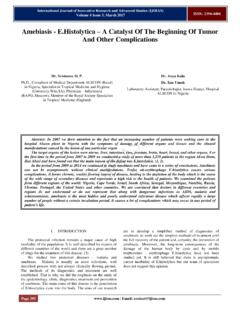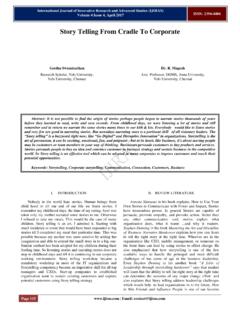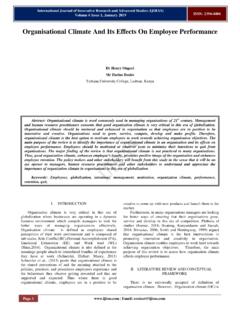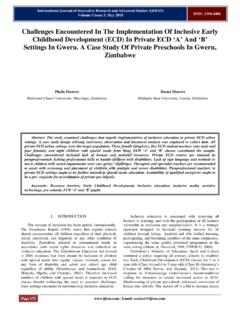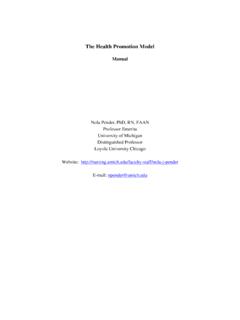Transcription of Conceptual Application Of Pender’s Health Promotion Model ...
1 Page 72 | Email: International Journal of Innovative Research and Advanced Studies (IJIRAS) Volume 3 Issue 11, October 2016 ISSN: 2394-4404 Conceptual Application Of pender s Health Promotion Model In The Promotion Of Adolescent Mental Health And Coping Abilities Through School Teachers Priya Joseph Professor, Little Flower College of Nursing Angamaly, Ernakulum District, Kerala, India I. INTRODUCTION The Twentieth century has witnessed a paradigm shift in the Health care delivery from prevention to Promotion ..Evidences show that addressing the underlying modifiable risk factors associated with chronic disease conditions will minimize their impact in terms of cost. Pioneers in nursing science have incorporated this knowledge and their multifaceted experiences into theories for better and more predicted Health outcomes.
2 At the same time these theories allows practitioners and researchers to frame and provide nursing interventions that are unique for each client. Nola pender s Health Promotion Model (HPM) is a middle-range predictive nursing theory that may be utilized to care for clients in a holistic manner and promote healthy behaviours. Here, this Model is used as a Conceptual basis in the mental Health Promotion of adolescents by enhancing their coping abilities through an Adolescent Coping Enhancement Training Programme [ACETP]. The school teachers who are in constant contact with the adolescents act as facilitators. II. PENDERS Health Promotion Model (HPM) The Health Promotion Model developed by Nola in 1982 was revised and presented in its new form in the year 1996. The focus of HPM is on Health Promotion by teaching the individuals to manage their own Health .
3 It is a framework that serves as a guide for exploration of the complex bio-psychosocial processes that motivate individuals to engage in healthy behaviours directed toward the enhancement of Health . The Health Promotion Model classifies Health behaviour determinants into three specific propositional groupings, namely, (a) Individual characteristics and experiences, (b) Behaviour specific affect, and (c) Behavioural outcome. pender s HPM presents this research a framework to understand plan and determine individual adolescents characteristics, behaviour effects, commitment plan towards a healthy and positive outcome. Abstract: pender s Health Promotion Model (HPM) plays a significant role in the context of Health problems which are caused by behaviors and are largely preventable. The applicability of the theory across the lifespan of individuals and variety of settings make it a better choice for the mental Health Promotion of adolescents in a school setting by teachers.
4 The Application of this competence Model , through coping enhancement programs, empowers adolescents to play an active role in initiating and maintaining their own Health Promotion behaviors, thereby increasing general well-being and actualizing their potential. Keywords: Adolescent, mental Health , teacher, school Page 73 | Email: International Journal of Innovative Research and Advanced Studies (IJIRAS) Volume 3 Issue 11, October 2016 ISSN: 2394-4404 Figure 1: Health Promotion Model (revised) pender N J III. INDIVIDUAL CHARACTERISTICS AND EXPERIENCES The personal factors and the prior related behaviours are two dimensions towards understanding individual characteristics and experiences. The personal factors are the biological, psychological and socio cultural factors of adolescents and the school teachers. Understanding of prior and existing behavioural characteristics is determined through a pre test initiative for both teachers and adolescents.
5 The teachers are assessed for their knowledge on mental Health assessment and the adolescents are assessed for their mental Health and coping abilities. IV. BEHAVIOUR SPECIFIC COGNITION AND AFFECT This includes perceived benefits of action, barriers to action, perceived self efficacy and activity related affect. The onset of puberty and adolescent development make the children vulnerable to many mental Health issues. The school teachers, who form an adolescent s interpersonal influence and environment, have the power to shape the benefits of action and to overcome barriers to action thereby leading to positive self efficacy and repetition of behaviour as an activity related affect on adolescents. The school teacher s general training is inadequate to handle the adolescent problems and therefore training teachers with activities for Health Promotion of adolescents will in turn empower the adolescents to manage their own issues of mental Health .
6 V. COMMITMENT TO A PLAN OF ACTION The behaviour specific knowledge and attitude of adolescent s and teachers, determine a plan of action and a road map towards achieving positive behavioural outcome. The mental Health Promotion activities are initiated by the school teacher after a training session for them by the researcher .The Health Promotion includes a skill training in improving mental Health and coping abilities. The trained skills include a set of skills needed for the adolescents to cope with the pressures of day to day stressors. These skills are in the domain of communication and interpersonal relationship, problem solving and decision making, emotion regulation and stress management .The commitment to carry out this plan of action at a given time for a specific period of time is directly proportional to the specific behavioural outcome.
7 VI. BEHAVIOURAL OUTCOME This is the attainment of positive Health outcomes for the adolescent in terms of better mental Health and coping abilities, which is assessed through repeated post test measurements. And for teachers, a positive behavioural outcome of adolescents leads to creating a positive interpersonal environment in the classroom and in the school. VI. CONCLUSION pender s Health Promotion Model (HPM) is used universally for research, education, and practice. The Health Promotion Model not only focuses on helping people achieve higher levels of well-being but also encourages Health professionals to provide positive resources to help patients achieve behaviour specific changes. The goal of the HPM is not just about helping patients prevent illness through their behaviour, but to look at ways in which a person can pursue better Health or ideal Health .
8 Figure 2: HPM Model applied to adolescent mental Health Promotion & and coping ability Page 74 | Email: International Journal of Innovative Research and Advanced Studies (IJIRAS) Volume 3 Issue 11, October 2016 ISSN: 2394-4404 REFERENCES [1] George, J .B. (1990). Nursing theories, the base for professional nursing practice. Appleton and Lange, USA. [2] Tomey, A. M., Alligood, R. (2002). Nursing theorists and their work. Mosby, USA. [3] Alligood, R. M., & Tomey, (2002). Nursing theory utilization an Application . Mosby, USA. [4] Parthasarathy, A., Nair, M. K. C., Gupta, A., (Ed.). (2016). Adolescent Health : Jaypee brothers Medical Publishing Company, New Delhi. [5] Bullaro A. Health Promotion in Theory and Practice University of Southern Indiana, Retrieved from Google. [6] Weisen, R. B., Orley, J., Evans, V., Lee, J., Sprunge, B., Pellaux, D., (1997).
9 Life skills education for children and adolescents in schools. Programme on mental Health World Health Organization.
